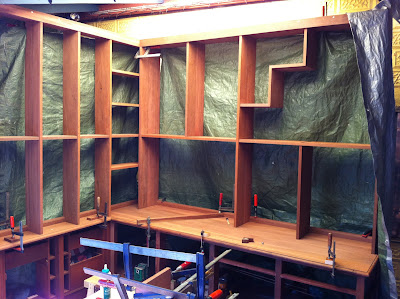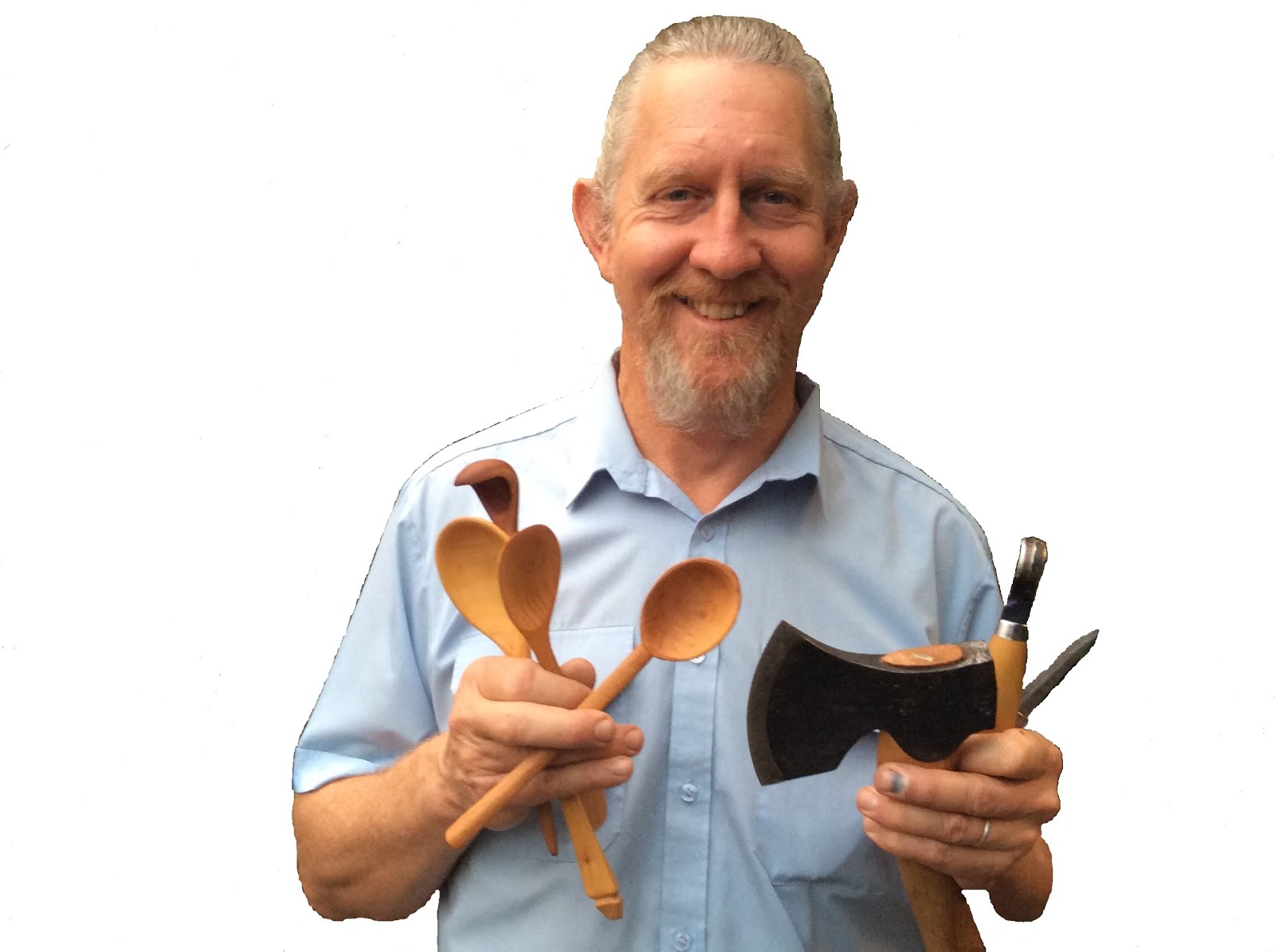The big jarrah cabinet I am making has been progressing slowly. Embarrassingly slowly. Interestingly, I have had an unprecedented number of group activities this year: across the Festivals, workshops, and school programs that I do. It's taken me be surprise, really, though it is what I have always intended, to transition from custom furniture to more group activities and teaching. My customers awaiting their beautiful jarrah cabinet have been incredibly patient. For that I am extremely grateful - but ultimately it will have been worth the wait. No question.
I am pleased to say a big step forward has taken place. The other day a friend came over to help me with the big glue-up of the top section. Phil's assistance was most appreciated, as it was a big job I couldn't do on my own. There was a huge amount of preparation before this event, with all the panels and fixed shelves having to be prepared and glued up, accurately cut to size, and every joint cut and test fitted, before the glue up could be undertaken.
 |
| That's most of the top sections assembled, minus one zig-zag shelf, the backing, crown mould, etc. |
This top section is sizeable, and made up of two main sections. The big top section is 2.2m long, 1.7m high and 300mm deep. The smaller section is 1.8m long, 1.7m high, and 200mm deep. It's all recycled jarrah, 22mm thick. It sits on the lower cabinet's top, in the housings cut into the top. Plenty of planning and sequencing was needed to bring all this together.
... So how can all these components and joints be cut accurately beforehand?
The importance of the "Story Stick".
Long before there were rules and tape measures, there was the Rod measure. It has been used for thousands of years. It still remains the most accurate way to transfer measurements. Three rods were created to build this cabinet, and all the information on them tranforms them into what we'd call a "Story Stick". The first rod records the position of the stiles in the big bottom cabinet and the relative positions of the top section verticals.
 |
| This rod/story stick is a piece of plywood 4 inches wide and just over 8 feet long. |
The second rod records the smaller bottom cabinet stile positions, and the relative positions of the verticals in the smaller top section. The third rod records the vertical shelf locations in the whole of the two top sections. All markings in the story stick are made with the sharp point of a marking knife, to aid accuracy. No fat pencil lines here!
 |
| The Storey Stick is placed on edge and the scribed lines transferred directly onto the components. |
It was these 3 story sticks which were used to mark out and cut all of the housings, lengths, and other dimensions. This was no job for a tape measure. This was a job for the most accurate way of transferring measurements - the story stick/rod measure. That's how come the glue-up went together well... Measurements were taken off the story stick also with the point of a marking knife, not the inaccuracy of a pencil. Otherwise, it is scary how much small errors can multiply across the width of a cabinet over a heap of joints.
 |
| Even the depth of the housings were marked. These provided the fixed shelf cut lengths. |
The upper right hand part of the big top section will have two "zig-zag" shelves. The Story Sticks once again are critical for getting these right. Jointed with half-blind dovetails at each bend, the component lengths were taken from the story sticks.
 |
| A zig-zag shelf cramped up and aligned on the set-out board. |
Again using the Story Sticks, a set-out board was made, with the upper right hand section being marked out and drawn exactly to full scale on a big piece of scrap MDF. The half-blind dovetails were cut (by hand of course) and then glued and cramped up. This was placed on the set-out board, and small scraps of wood were nailed to the board such as to ensure that the zig-zag was exactly in the right position as marked on the set-out board. Once the glue is dry and the joints cleaned up, the zig-zag shelf will fit beautifully into the two housings which are awaiting it.
 |
| Howzat? A half-blind dovetail with mitred corner on the face edge. Just cramped up. Nice. |
You can see from some of the close-up pictures that the edges profiled with a Scratch Stock have worked well. An earlier
post told about these. This is to match an existing antique which will share the same room as this cabinet
 |
| The stopped housing joints have come up well - thanks to the ever reliable Story Sticks. |
The set-out board is really a two dimensional version of a Story Stick. They are a very effective tool for measuring and making components - especially when making furniture I find. I also use them for setting out stringers when building staircases.
The rod measure is just as relevant and reliable today as it was for the ancient Egyptians. Write all over it and add more details, and the rod measure is transformed into a Story Stick.
When building any big piece of furniture or joinery, the Story Stick is one of your best friends.
.jpg)


